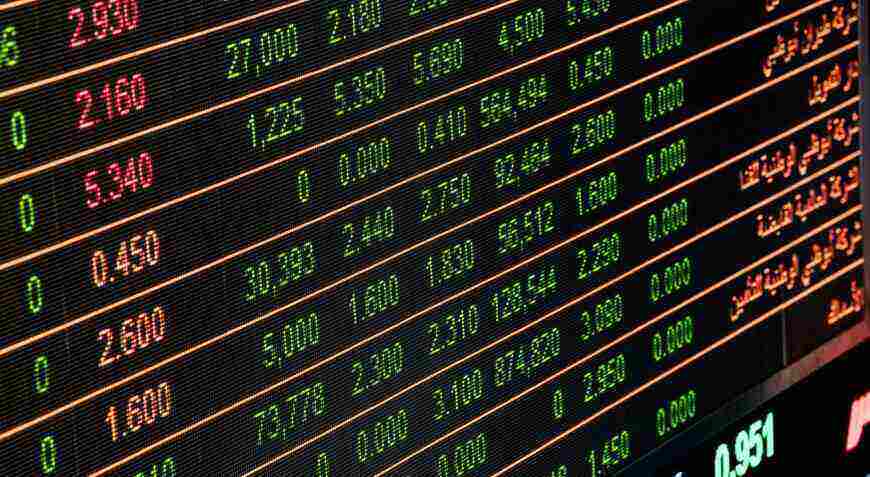Stock trading is a financial activity that involves the buying and selling of securities on a public exchange in order to gain profits.
Generally, traders seek to make money from small price movements in highly liquid markets by taking advantage of market volatility. It can be performed in a variety of different products: stocks, commodities, foreign exchange products (FOREX), and cryptocurrency.

Traders may frequently buy or sell securities depending on their assessment of the value. For example, if they believe that the securities value will increase in the future, they will purchase it with the expectation of profit when it does go up.
If they determine that the business fundamentals are strong enough to sustain its current value and do not expect it to drop soon, they might choose to buy in order to reap consistent profits over time while also receiving dividend payments.
On the flip side, traders may also sell security if they think that its price will decrease in the near future.
This is called “speculation” and enables traders to benefit from quick price changes without having to commit long-term capital into a particular asset class.
Trading Types Explained
1. Day Trading
This type of trading involves making decisions in the short-term, usually within one day. It is a risky endeavor as traders must react quickly to changes in the markets and have access to high amounts of capital. Traders often use technical analysis techniques, including chart patterns and indicators, to capture quick profits from small price movements.
2. Swing Trading
Swing trading is also a type of short-term trading that looks to capitalize on small price movements within an individual market session or trend. Traders typically buy and sell based on their analysis of momentum and may hold positions for a few days to several weeks depending on the trades’ success or failure. This type of trading requires research into market trends and patience in waiting for conditions to be right before entering or exiting a position.
3. Scalping
Scalping is similar to day trading but with a much smaller profit objective — scalpers look to make tiny profits from each trade by holding positions for only seconds or minutes at a time and riding out the slightest moves in prices. This strategy carries much greater risk than longer-term strategies due to its reliance on fast decision-making without regard for fundamentals or overall market direction.
4. Position Trading
Position trading takes a longer term approach than other strategies, looking for trends that last anywhere from weeks to months (or even years). These traders often use fundamental analysis techniques when selecting investments, meaning they examine economic data such as interest rates, inflation reports, GDP numbers, etc. In order to determine which stocks will make good investments over time periods ranging from months up through many years.
5. Momentum Trading
Momentum traders take advantage of prevailing trends by entering and exiting positions quickly with the goal of capturing small gains over short intervals such as days or weeks as opposed to longer-term strategies which seek bigger profits but over longer timeframes.
This strategy requires significant capital (often hundreds of thousands) as well as sophisticated analysis software and familiarity with major news sources so that trades can be executed rapidly when opportunities appear across multiple markets simultaneously.
6. High Frequency Trading (HFT)
HFT uses extremely advanced algorithms that are capable of analyzing large amounts of data and executing trades within fractions of a second – sometimes orders are made without any human input whatsoever!
This type of trading has been around since the late 1990s and it has become increasingly popular because it allows traders to capitalize on fleeting price discrepancies faster than ever before which can lead to greater profits if done successfully.
Due to its immensely fast nature there are also more risks associated with HFT than other types of trading strategies because it can easily create instability in markets if done unchecked.

Wanna see the latest events in crypto market?
Maybe websites such as CoinMarketCal which is the leading economic calendar for cryptoassets (coins, tokens and NFTs) can help you in your adventure. They cover all events that help investors make better decisions.
Best Automated Trading Platforms: Check out the Top 10 Trading Platforms in November
- eToro Copy Trading: The Overall Best Automated Trading Platform
- Learn2Trade: Easily Trade Forex And Crypto
- Cryptosignals.org: High-Quality Crypto Signals At Your Fingertips
- Bitcoin Era: High-Quality AI-Powered Trading System
- Bitcode AI: Great Trading Platform For Beginners
- Oil Profit: Trade Oil Markets Like A Pro
- Bitcoin Prime: Faster Speeds Than The Crypto Market
- Bitcoin Loophole: Access Leverage Trading In A Snap
- NFT Profit: Multi-Asset Support For Cryptocurrencies
- Immediate Edge: Highest Win Rate In The Market
Best Cryptocurrency Trading Platforms November 2025
- Coinbase: Best for crypto exchange prices
- Robinhood Crypto: Best for online crypto brokers
- Gemini: Best for crypto exchanges in real time
- Webull Crypto: Best for online cryptocurrency trading
- TradeStation Crypto: Best for crypto transactions
- eToro: Best and easiest platform to use
- SoFi Active Investing Crypto: Best support for online crypto brokers
- Binance.US: Best fees for crypto exchanges
- Kraken: Best for various crypto related exchanges
- Crypto.com: Biggest platform for crypto exchanges
- Firstrade Crypto: Best for startup online crypto brokers
Best Trading Robots November 2025
- Bitcoin Prime – Overall Best Trading Robot in 2023
- Oil Profit – 24/7 Automated Bitcoin Trading
- Bitcoin Era – Top Bitcoin Robot for New Crypto Traders
- Quantum AI – Powerful Crypto Robot with Claimed 90% Win Rate
- eKrona – Automated Trading Based on the eKrona Currency
- Bitcoin Profit – Ultra-fast Trade Execution across 50+ Markets
- NFT Profit – Automatically Trade NFTs for a Profit
- Bitcoin Revolution – Trade Crypto with 5,000:1 Leverage
- Crypto Bank – BTC Robot with No Fees or Commissions
- Teslacoin – You can invest in TeslaCoin while Trading other Cryptocurrencies
Best Forex Trading Robots November 2025
- Forex Fur
- 1000pip Climber System
- Coinrule
- Forex Gump
- ForexVPS
- Centobot
- Forex Trendy
- EA Builder
How to Day Trade Stocks: Explained in 5 Easy Steps
Day trading stocks involves analyzing the stock market and buying and selling stocks quickly. Traders use technical analysis to identify short-term price trends and look for opportunities to make profits. They enter into trades when they believe the market will move in their favor, and then close out those trades when their targets are met or when the risk/reward ratio no longer looks favorable. Day traders must be able to analyze the markets quickly and exit positions before large losses occur. Traders have disciplined money management rules to stay profitable over time.
Step 1: Set Up a Trading Account
The first step to day trading stocks is to set up a trading account with an online broker. This will require some paperwork and could take up to several days before being approved.
It’s important to make sure that the broker is properly licensed and regulated, as this will ensure that your funds are secure and transactions are executed as quickly and accurately as possible. When setting up the account, you’ll also need to decide what type of order execution you prefer, whether it’s limit orders, market orders or stop-loss orders.
Step 2: Research Stocks and Analyze the Markets
Before executing any trades, it’s important to thoroughly research different stocks and analyze the associated markets. To do this efficiently and effectively, day traders employ technical analysis tools such as charting software to identify entry points and potential trades.
Fundamental analysis is also used when researching a stock in order to determine its value. The goal here is to gain an understanding of the underlying business and industry so that you can make informed decisions.
Step 3: Choose Your Time Frame for Trading
As a day trader, you must decide on how much time each day you want to dedicate towards trading activities. Do you want long-term investments or do you prefer shorter duration trades? Knowing your timeframe beforehand allows you to be better prepared when entering into positions with specific outlooks for each individual trade or investment position.
Step 4: Develop Trading Strategies
Once all of the necessary research is done, you should develop appropriate strategies for executing trades. Different types of strategies include scalping, swing trading, hedging, momentum trading and more. Each strategy carries different levels of risk so it’s important for traders to understand their own risk tolerance before deciding which one works best for them.
Step 5: Manage Your Risk by Setting Stop Loss Orders & Limit Orders
When day trading stocks, you must always have a plan in place in order to protect your capital from potential losses.
Some people set stop loss orders, which means that their trade will end and they will stop losing money once the stock reaches a certain point. Other people use limit orders, which means that they will only enter a trade when the stock reaches a certain price.
Diversifying an investment portfolio across multiple stocks can help minimize risk by spreading out losses across various sectors or industries instead of having all eggs in one basket with only one stock position intact.
How to Trade NFTs: 5 Step Guide for Dummies
1. Familiarize Yourself with NFTs
Before you start trading NFTs, it is important to understand the concept of what an NFT is and what it represents. An NFT (non-fungible token) is a digital asset that certifies the ownership of a unique digital item, such as art, music, fashion products, etc. They are typically stored in a blockchain platform like Ethereum, where each token is cryptographically secured and has its own blockchain ID, which serves as proof of ownership.
2. Find a Marketplace or Platform to Trade NFTs
Before you can start trading NFTs, you need to find a marketplace or platform that offers them. There are many platforms available for trading NFTs such as OpenSea, Rarible and SuperRare. Each platform offers different features and advantages so be sure to do your research before choosing one to trade on.
3. Research the Market before Investing in an NFT
Just like with any investment decision, it’s important to do your due diligence and research the market before investing in any particular digital asset. Look at market trends in terms of buying and selling prices for particular types of NFTs as well as researching the artists/creators who have created them.
This will give you an idea of which pieces are more likely to appreciate in value over time. Also look at review sites such as Trustpilot or Digital Arts Radar for customer reviews about the various platforms available for trading NFTs so that you can make an informed decision about which platform best suits your needs.
4. Get Verified on a Trading Platform & Fund Your Account.
Once you’ve chosen your desired trading platform, you will go through their verification process before allowing you to begin trading on the platform. This usually involves providing some form of ID such as your driver’s license or passport along with other necessary documents depending on the platform’s requirements.
You will also need to fund your account before making any purchases by connecting it with either a bank account or cryptocurrency wallet like Coinbase or MetaMask, etc.
5. Start Trading & Monitor Prices Regularly
Once your account has been verified and funded, you can start searching for digital assets that interest you and start making trades accordingly. It’s important to monitor prices.
Also, monitoring new releases from established creators may be beneficial if they offer lower prices than existing listings. This could result in greater returns.
How to Trade Currency on Forex
Research the different currency pairs available for trading
Forex trading involves pairing two different currencies against each other, such as the US Dollar (USD) and the Euro (EUR). Each currency pair has its own “spread” which is the difference between its ask and bid prices. Understanding these spreads is important in order to determine when is the best time to enter a trade.
Learn about leverage and margin requirements
To help you amplify your potential profits, forex brokers typically offer leverage to traders. Leverage allows you to borrow money from your broker in order to increase your exposure on a given trade. However, it also increases risk as losses can be magnified quickly if not managed properly. Additionally, most brokers will require you to maintain a certain amount of margin in your account at all times in order to cover possible losses.
Choose a trading platform and open an account with a credible broker
Different online platforms may have different features that you may find useful or attractive; do some research and select one that fits your needs best. Moreover, selecting a trusted broker with good reviews is also essential in order to ensure that your funds are safe and secure while trading on the forex market.
Understand technical analysis tools
Trend lines, support/resistance levels, candlesticks charts, indicators etc., which can help you identify key trends and signals in price movement over time. Also learn how fundamental analysis factors such as news events or economic reports can affect price movements of specific currency pairs so that you can make informed decisions when entering trades.
Begin placing orders on the market
After making sure you understand all of the risks involved with investing on forex markets; start slowly by placing small orders at first until you get more comfortable with trading strategies and risk management techniques before risking larger sums of capital into trades. It’s always recommended to practice using demo accounts before real money trading begins so that mistakes made during learning phases won’t cost actual money losses.
Disclaimer: Investing can be quite a wild ride – especially when you don’t know the terrain! To keep things from getting too rocky, take some time beforehand to get familiar with all of the risks involved. Our site is here to up your investor game by providing all available intel about platforms and trends, but we don’t take responsibility nor can we be held accountable as advisors. That being said, it’s still important for you to make educated decisions that match what works best for YOU – just remember: no amount of savvy will guarantee success or protect against loss so invest money you can spare.











